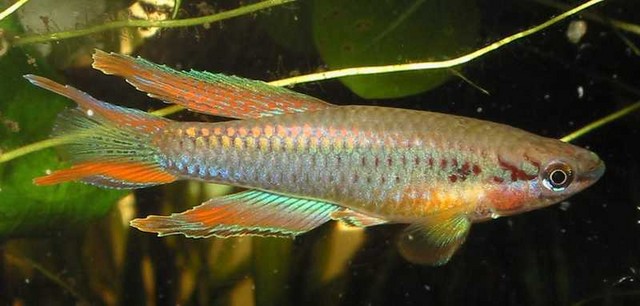Pseudepiplatys annulatus, known as the Clown killie, Banded panchax or Rocket panchax, was once much more available in the Keystone Killie Group. I have been trying to get them reestablished in my fish room, as it is such a beautiful little fish. So when Lee Harper volunteered to bid on fish at the auction that he and Clay Crawford were attending out at the mini convention in Milwaukee, I asked Lee to try to buy me two pair of annulatus. Lee was able to get me only a trio of a male and two females, as there were not a lot fish available and there were other bidders. I set the trio up in a planted 2 and 1/2 gallon tank on November 8, 2012, and was disappointed when a few weeks later one of the young females matured enough to show his true finnage as a male. A reverse trio. Well I still had hopes with the one female.
 |
| Pseudepiplatys annulatus male, December 18, 2012 |
 |
| Female, December 18, 2012 |
I was thrilled when on December 5th, I found three eggs while picking through some java moss from their tank. Tiny, tiny little eggs, but one was dark, indicating a developing baby. It should hatch real soon, as the literature suggests a two week incubation period. In the meantime, I had been checking the aquarium for baby fish, as annulatus are known for tolerating their fry in the tank with them. Yesterday, December 18th, I was delighted to count at least five very small fry in the tank. At first, the very small fry stay at the very top of the tank, often right at the meniscus at the edges of the tank.
 |
| Spotted one |
 |
| And another |
Yes, the babies start out tiny. They feed on infusuria that they find naturally available in the tank. I may suck up a few of the babies in a turkey baster to see if I can provide them with more food by keeping them in a separate container. Or I might try to add more microscopic live food to the breeding tank. In either case, I am happy to be getting babies.
Update 12/31/2012: Dipped 12 babies from the adult breeder tank, and separated them to three different starter containers. None of the eggs that have been picked have hatched yet, many days passed the supposed hatching date. Maybe letting them hatch in the parents tank is the way to go.
Update 2/23/2013: Dipped maybe eight babies from reverse trio tank.
Update 3/23/2013: Dipped eleven babies from reverse trio tank.
Update 4/15/2013: Two pair of sex-able juveniles moved to a 5 1/2 gallon tank to establish another breeding tank. Five very young babies and four decent sized babies dipped out of reverse trio breeding tank. Those babies set up to containers with the five smallest together, and the little larger one split to two each per container.
Update 5/8/2013: Five very young babies and three decent sized babies dipped out of reverse trio breeding tank. Put the 5 and 3 into two separate rearing containers.
Update 5/28/2013: Three very young babies and four decent sized babies dipped out of reverse trio tank. Put them in two separate starter containers. A lone juvenile female was put in with two adult males in a 5 1/2 gallon tank to hopefully start a reverse trio breeding tank. No evidence of fry yet in the tank with three males and two females.
Update 3/16/2014: Had not spotted a baby in a very long time, and am down to a pair and a single male juvenile. Two mornings ago before lights came on, I shined a flashlight into the parent tank and spotted one lone minuscule fry! So the parents are fertile, and they are laying eggs. Maybe they are eating the fry. This morning I moved the pair to a different well planted 2 1/2 gallon tank. Hoping to find fry pop up in the newly vacated tank.
Update 12/3/15: The fish from the 3/16/14 update have bee long gone. I purchased six juvies from Gary Haas on 9/12/15 and put them all in a 2 1/2 gallon. Turns out to be three pair! One pair left in the 2.5, one pair moved to a 10 gallon with three cherry shrimp, and one pair moved to a shallow sweater box. The fish look good and have been taking grindals heartily.













